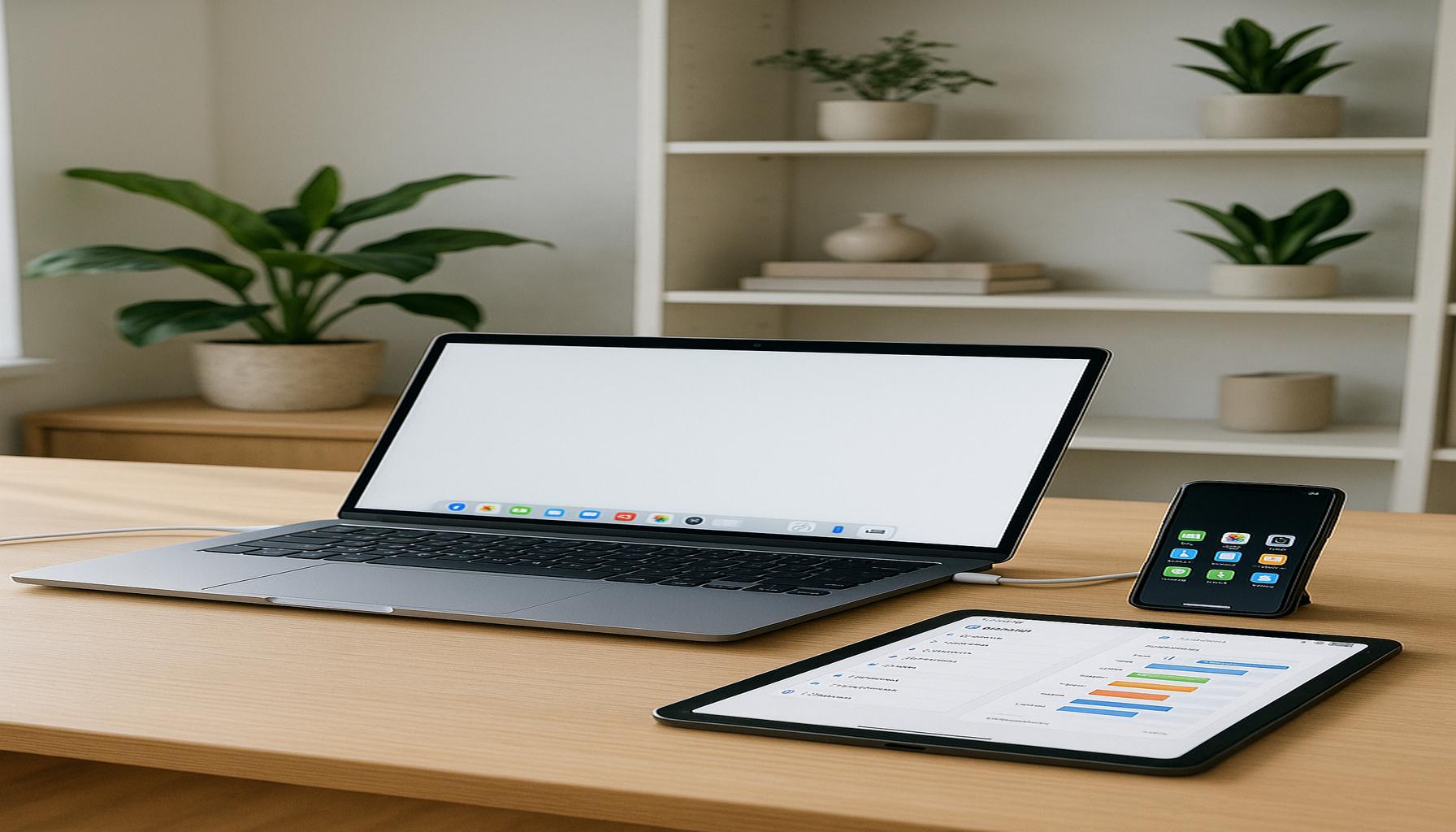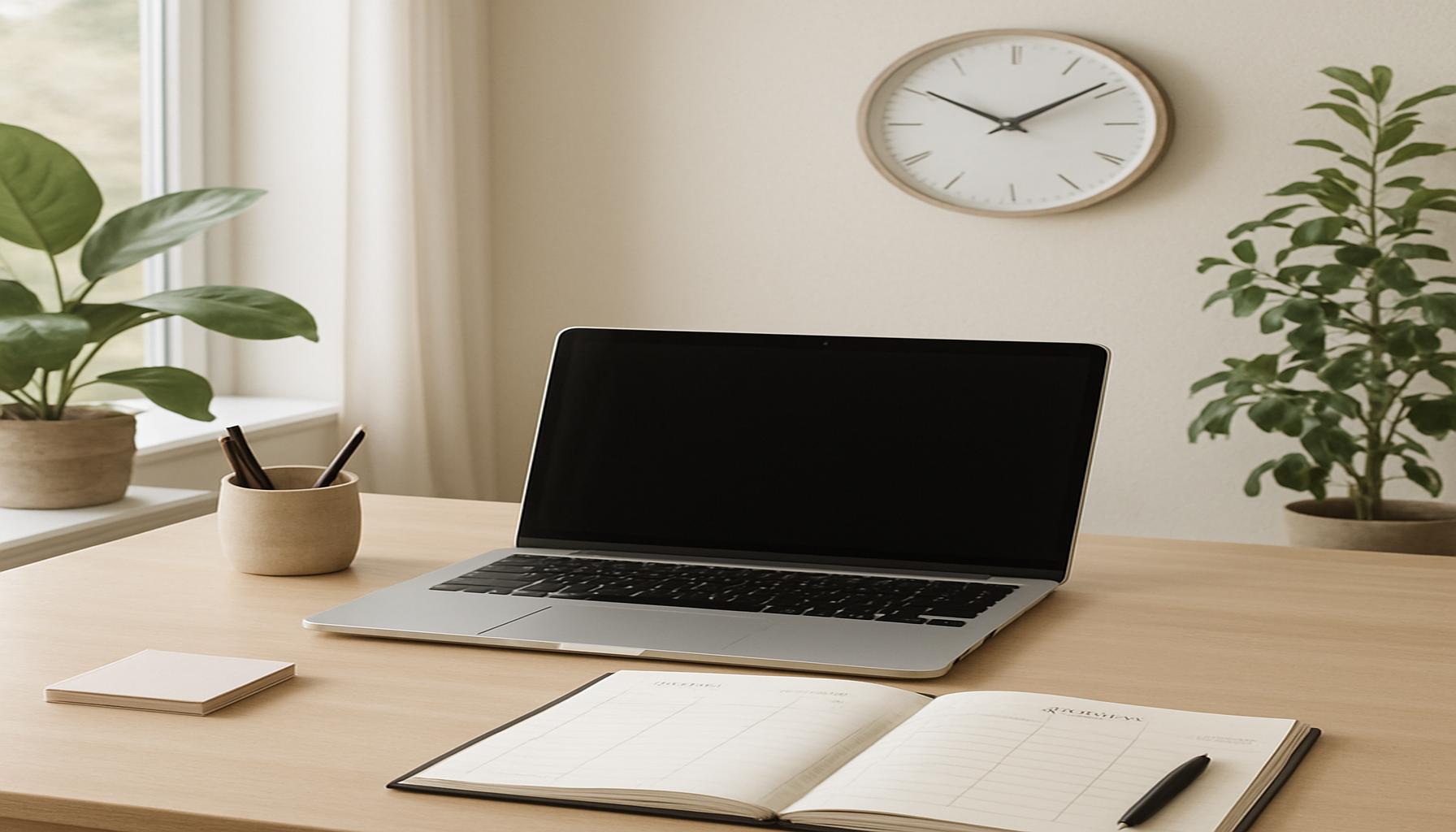Digital Decluttering Guide Boost Productivity by Organizing Devices

Embrace Digital Minimalism
In an age where we are constantly bombarded by information, digital decluttering has become essential for enhancing our productivity. As more of our lives unfold online, the clutter in our devices can weigh us down, leading to stress and decreased efficiency. By organizing our digital spaces, we not only free up mental bandwidth but also create an environment that fosters creativity and focus.
The Rise of Minimalism in the Digital World
The minimalism movement encourages us to simplify our lives, and this principle translates seamlessly into our digital lives as well. Decluttering your devices means more than just deleting unused apps or emails; it’s about establishing a system that enhances your workflow. Here are a few key benefits to consider:
- Reduced distractions: Fewer notifications and clutter lead to better concentration.
- Improved organization: Streamlined systems save time and reduce overwhelm.
- Enhanced productivity: A tidy digital space encourages efficiency and creativity.
As we delve into the best strategies for digital decluttering, get ready to explore the Top 5 techniques that can transform the way you manage your devices. By implementing these strategies, you will find the balance and clarity that is often lost in our hyper-connected lives.
Top 5 Strategies for Digital Decluttering: Organize Your Devices and Boost Productivity
In an era characterized by constant connectivity and a relentless influx of information, the ability to manage our digital environments has become indispensable. Digital clutter—manifested through chaotic desktops, overflowing inboxes, and unmanageable digital libraries—can sap our productivity, amplify stress, and evoke a perpetual sense of overwhelm. Harnessing effective digital decluttering strategies is not merely about tidiness; it’s about transforming the way we interact with our technology. Here, we unveil the top five strategies designed to streamline your digital life and substantially bolster productivity.
5. Categorize and Prioritize Files
At the heart of digital decluttering lies the strategy to categorize and prioritize your files. Envision your digital world as a bustling city, with each file either contributing to order or chaos. Begin by creating broad categories that mirror your work and lifestyle. Possible high-level folders could include Work, Personal, Projects, and Important Documents. These main categories provide a scaffold upon which a more detailed structure can be built.

Within each category, the creation of subcategories helps refine organization. For instance, within a Work folder, subfolders might include Reports, Presentations, Meeting Notes, and Emails. The act of categorization simplifies the search process, allowing quicker retrieval and more efficient management of your digital resources.
Equally important is the concept of prioritization. Not all files are equal in value or urgency. Assess each file’s importance relative to your immediate and long-term objectives. Files crucial for an upcoming presentation should take precedence over archival material. Regular review sessions are essential, ensuring every document maintains its relevance, and obsolete items are removed.
- Identify primary categories for comprehensive organization.
- Create detailed subcategories for precise file management.
- Regularly assess and adapt categories to maintain relevance.
4. Unsubscribe and Reduce Email Clutter
The email inbox, often inundated with mountains of correspondences, can be a significant source of digital clutter. The act of opening one’s inbox to find hundreds of unread messages can be mentally exhausting. To declutter, begin by unsubscribing from unnecessary newsletters and promotional emails. Many of these emails are the digital equivalent of junk mail, offering little value while consuming your attention and time.
The strategic use of email filters can further streamline your digital communication. Filters allow the automatic sorting of incoming emails into folders—such as Priority, Personal, and Spam—based on rules you establish. This automation not only saves time but also empowers you to focus on what truly matters.
Timing is another critical aspect. Schedule regular times to check your email—perhaps hourly or in specific intervals aligned with your work rhythm—to avoid constant distractions that fragment your focus.
- Proactively unsubscribe from non-essential newsletters.
- Develop and employ email filters for automatic organization.
- Establish scheduled intervals for efficient email management.
3. Limit Applications and Software
In our pursuit of efficiency, we often download applications and software with the intention of improving productivity. However, these digital tools can become sources of clutter if not rigorously managed. To optimize your digital workspace, regularly evaluate and limit the applications you use.
Assess each app for its utility. Does it substantially enhance your workflow or duplicate functions available elsewhere? If an application neither fulfills a necessary function nor improves your efficiency, consider deleting it. By retaining only impactful tools, you cultivate a more focused digital environment.
Embrace productivity applications that consolidate tasks and encourage cohesive organization. Task managers and note-taking apps are excellent examples, offering centralized platforms from which to orchestrate your professional and personal duties.
- Evaluate each application’s contribution to your productivity.
- Delete those that add clutter rather than value.
- Incorporate central productivity apps for streamlined efficiency.
2. Regular Digital Cleanup Sessions
Just as regular physical cleaning keeps our environments serene, regular digital cleanup sessions are essential for maintaining an orderly digital life. Schedule dedicated times—whether weekly, monthly, or quarterly—for digital housekeeping. Consider these moments a commitment to your mental clarity and digital efficiency.
During these sessions, focus on deleting obsolete files, refreshing email categorizations, and assessing software relevance. Consistency in this practice prevents the reaccumulation of clutter, ensuring your digital ecosystem remains an asset, not a liability.
Document your progress through simple reflective notes. What improvements have you noticed in productivity? What areas continue to pose challenges? This ongoing evaluation enables sustained improvement and personal accountability.
- Designate specific times for digital decluttering activities.
- Opt for a routine that aligns with your personal workflow.
- Record progress and challenges to inform future efforts.
1. Implement a Cloud Storage System
When aiming for significant digital decluttering, few techniques are as transformative as implementing a cloud storage system. Offloading files and documents from local devices to the cloud liberates storage space while ensuring your data is accessible anytime, anywhere. Notable services, such as Google Drive, Dropbox, and OneDrive, provide robust organizational platforms for personal and collaborative use.
Cloud storage not only mitigates the risk of data loss but also emphasizes a culture of connectivity and collaboration. Sharing important documents with colleagues is seamless and efficient. Furthermore, cloud platforms often offer features enabling structured organization through folders and tags, facilitating easy retrieval and management.
The shift to cloud storage is more than a matter of convenience; it is an evolution towards a lighter, more efficient digital life where the right data is always at your fingertips, and unnecessary clutter becomes a remnant of the past.
- Determine a cloud service well-suited to your particular needs.
- Organize files within the cloud for systematic access.
- Commit to a cloud-based lifestyle for enhanced efficiency and collaboration.
Adopting these strategies will not only declutter your digital world but also set the stage for a more focused, productive, and stress-free existence. The journey towards an organized digital life is ongoing, and each step you take is a stride towards harnessing technology for its greatest potential. As you refine your digital behavior, you’ll discover newfound clarity and vigor in both your personal and professional realms.
| Category | Key Features | Advantages | Disadvantages | Ideal Users |
|---|---|---|---|---|
| Data Management Tools | Applications designed to organize files and data efficiently. | Streamlines workflow, enhances accessibility, and minimizes data loss risks. | Learning curve might be required for some tools; some can be costly. | Professionals who handle large amounts of data, such as data analysts or marketers. |
| Cloud Storage Solutions | Online spaces for file storage accessible from any device. | Facilitates collaboration and access from remote locations, ensuring that files are safe and easily shareable. | Dependent on internet access and can lead to privacy concerns. | Individuals and teams working from various locations or on collaborative projects. |
| Task Management Software | Tools that help organize tasks, set deadlines, and improve focus. | Enhances productivity through organized task lists and reminders, helping prioritize important work. | Can create pressure to meet deadlines, making some users feel overwhelmed. | Students and professionals looking to boost their time management skills. |
| Digital Minimalism Practices | Approaches that advocate for reducing digital clutter. | Promotes mental clarity and reduces distractions, allowing better focus on what truly matters. | Requires commitment, as it may involve substantial changes in habits and digital consumption. | Anyone facing digital burnout or seeking a more focused digital life. |
The digital organization is not just about applying tools or software; it’s about embracing a holistic strategy that incorporates various methodologies to ensure productivity. Data Management Tools offer a systematic approach to filing and archiving your digital assets, thus reducing the chaos typically associated with data retrieval. Meanwhile, Cloud Storage Solutions extend this focus on organization by providing flexible access to vital files, crucial for remote work scenarios that dominate today’s working landscape.Moving towards Task Management Software, these tools are instrumental in breaking down larger projects into manageable tasks, integrating reminders that can keep procrastination at bay. However, as beneficial as these applications can be, they can also bring unwanted pressure, necessitating a balance in their use.Finally, Digital Minimalism Practices challenge the very nature of our digital engagements, advocating for a conscious reduction in digital noise, fostering a clearer mental framework. Those willing to adopt these techniques often find their cognitive load lightened, enhancing their overall productivity. Each category possesses distinctive characteristics that support specific user needs, allowing for a tailored approach to digital decluttering.
Frequently Asked Questions about Digital Decluttering
Why is digital decluttering important for productivity?
Digital decluttering is crucial as it helps create a more organized and efficient digital workspace. By removing unnecessary files and applications, you can minimize distractions and save time searching for important information. Research has shown that a cluttered digital environment can lead to decreased productivity and increased stress levels. Keeping digital spaces tidy allows for a more focused mindset, leading to improved performance and task completion.
How often should I declutter my digital devices?
The frequency of digital decluttering largely depends on your usage habits and personal preferences. However, a practical approach is to schedule quarterly reviews of your devices. Regular maintenance helps prevent the accumulation of digital clutter and ensures that your digital environment remains streamlined. Some experts suggest small, weekly tidying sessions to avoid the overwhelming task of a massive overhaul.
What are some effective strategies for organizing my digital files?
Start by establishing a clear and logical folder structure that mirrors your workflow, grouping similar documents together. Utilize meaningful naming conventions to make file retrieval easier. Take advantage of cloud storage solutions for backing up essential documents and freeing up space on your devices. Implement the two-minute rule: if a digital task takes less than two minutes, do it immediately. This strategy prevents small tasks from piling up and becoming unmanageable.
Can apps and software help with digital decluttering?
Yes, there are numerous tools designed to aid in digital decluttering. File organizers, duplicate file finders, and automated cleaning software can significantly reduce the time and effort required for manual decluttering. Calendar and task management apps also help streamline productivity by keeping schedules and to-do lists organized. Incorporating these tools into your routine can optimize your digital environment, allowing you to focus on higher-value tasks.
What should I do with files and applications I rarely use?
For files and applications you seldom use, consider archiving or storing them on an external drive or in the cloud. This approach frees up valuable space on your primary devices while ensuring access if needed in the future. Assess the importance and relevance of each item; if they’re no longer beneficial, contemplate deleting them to simplify your digital landscape. Regular evaluation of seldom-used items aids in maintaining an efficient and uncluttered digital workspace.
Conclusion
In the dynamic and ever-evolving digital landscape, where endless information competes for our attention, the art of decluttering digital spaces has become a necessity rather than a luxury. Throughout the article, we delved into the myriad strategies that can be employed to streamline our digital lives, ultimately enhancing not only our productivity but also our mental clarity. By embracing methodologies drawn from minimalism and personal organization, the journey to a cleaner, more efficient digital environment becomes a realistic and achievable goal.
Main Takeaways
- Prioritize Digital Cleanup: Start with organizing your emails, using tools like filters and labels to manage communication effortlessly.
- Manage Apps and Software: Regularly audit and uninstall unused applications to free up space and reduce distractions.
- Utilize Cloud Storage Solutions: Embrace cloud storage for an organized, accessible, and space-saving way to manage files.
- Streamline Digital Devices: Sync and update devices consistently to ensure smooth and integrated functionality.
- Set Regularly Scheduled Maintenance: Establish routine check-ups to maintain order and efficiency in your digital ecosystems.
In sum, the significance of digital decluttering cannot be overstated. As we strive for digital minimalism and personal organization, we cultivate a space that encourages creativity, focus, and peace of mind. The impact of organizational strategies is far-reaching, influencing both our professional and personal spheres. By adopting these strategies, we empower ourselves to take control of our digital environments, transforming them into allies in our pursuit of productivity.
In this age where information overdoses are common, embracing decluttering ensures that we remain masters and not slaves to our digital world. The journey towards a more organized digital landscape beckons, promising rewards of clarity and efficiency that are well worth the effort.


